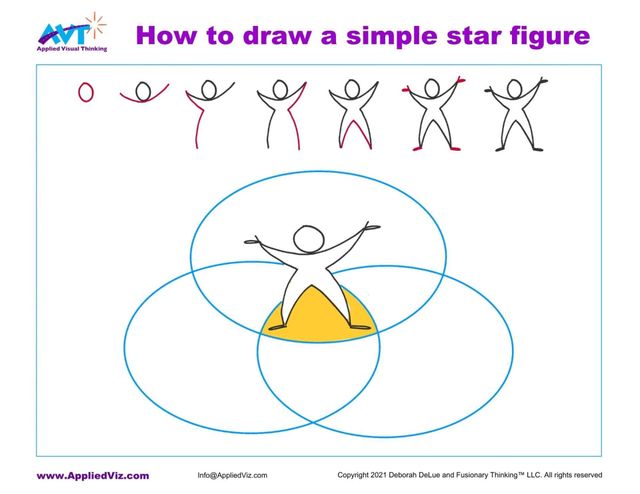Explore Your Happy Place!
The Art of Applied Visual Thinking
I openly admit to being a movie buff. One of my earliest movie memories is seeing Yellow Submarine at the big movie
house in our neighborhood. It had once been a grand movie palace. By the time I went to see Yellow Submarine there,
a lot of the shine had worn off or been covered in sticky movie candy residue, but that didn't matter to me; I loved
going there. That simple trip started my love affair with movies. I still love them, any movie (except gory ones), any time,
any place. The big screen, the comfy seats, the popcorn smell, the actors, the story, the dialog, becoming immersed
in the story. Going to the movies is one of my…
This week we're going to use a Venn diagram to analyze a few of our happy places. According to Wikipedia,
"A Venn diagram
is a widely-used diagram style that shows the logical relation between sets, popularized by John Venn in the 1880s."
To create a Venn Diagram, you just need to draw a few overlapping circles. Each circle represents a set of information; the intersections contain information that
the sets have in common. Not familiar with Venn Diagrams? Check out our
FOUNDATIONS course.
Grab your pens and some paper or your template, and let's dive in.
Step 1) Do a little brainstorming - Think of at least 3 places where you experience that happy feeling. Jot down some notes about each of your happy places.
- Where is it?
- What are the sights, sounds, and smells of that place?
- Is it dark or bright? Warm or cool? Quiet or loud?
- Is it full of other people, or is it mostly empty?
- Is it jammed full of exciting stuff, or is it spare and minimalist?
- What do you do in each place? Are you sitting, standing,
or moving around? - What is your fondest memory of that place?
Want to take a
deeper dive into
your happy places?
Grab a template
and play along.
Step 2)
Create a Venn Diagram - Draw a set of overlapping circles, one for each of your happy places, then give each
ring the name of one of your happy places.
Step 3)
Plot your information
- This is the fun part! Using your brainstorming notes begin listing attributes about
each of your happy places. If the feature is:
- Unique to one happy place, add it to the correct circle
- Common to more than one happy place, add it to the
intersection of the two circles - Common to all of your happy places, add it to the center
where all of the circles overlap
Keep going until you run out of ideas. If you run out of space in an intersection add the ideas along the side and connect
with an arrow. For extra credit, use color, icons, connectors, and containers to give your diagram some pizzazz, show
meaning, and make connections.
Step 4) Take a step back - Look at your diagram from a distance. What do you notice? Do the intersections spark any new ideas? Are there other places that might have many of the same attributes, somewhere that might become a new happy place?
Step 5)
Schedule a visit
- Here's the payoff! Schedule some time on your calendar to visit a potential new happy place in the next week. Even if you can only spare 20 minutes, relish spending time there, notice how you feel in the space. Pay attention
to the things that capture your imagination. Notice if you have that happy feeling. If you do, know that you can come back again anytime you want to experience that happy feeling.














